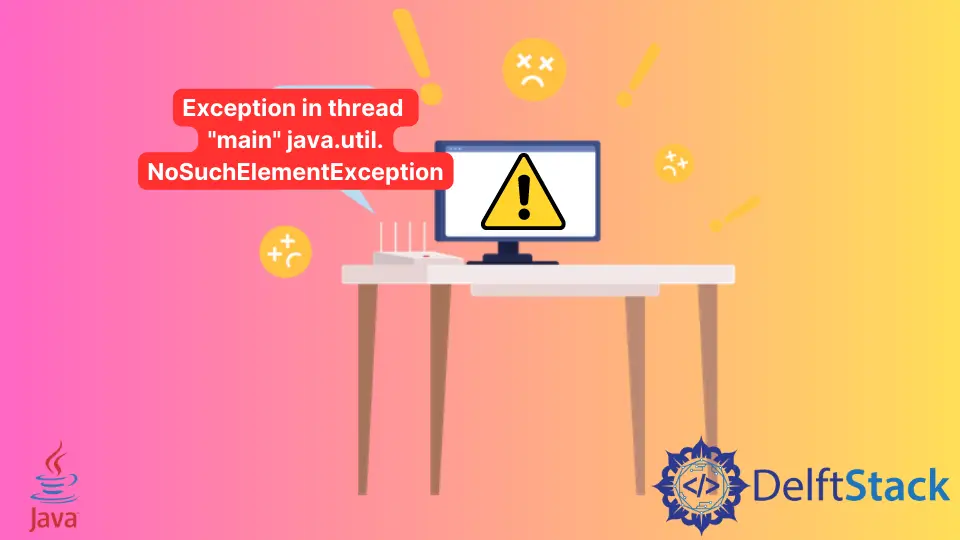修復 Java 中的 NoSuchElementException 錯誤
- 在 Java 中使用迭代器時出現 NoSuchElementException
- 在 Java 中使用列舉時出現 NoSuchElementException
- 在 Java 中使用 StringTokenizer 時出現 NoSuchElementException
- 在 Java 中使用 Scanner 類時出現 NoSuchElementException

異常是在程式執行期間發生的事件。發生異常時會影響正常的程式流程,導致程式異常終止。本教程將討論 java.util.NoSuchElementException 以及如何在 Java 中處理它。
NoSuchElementException 繼承自 RuntimeException 類,這意味著它是一個未經檢查的異常。編譯器不處理未經檢查的異常,因為它們發生在執行時。
NoSuchElementException 由 Scanner 類、Iterator 介面、Enumerator 介面和 StringTokenizer 類丟擲。這些類具有訪問器的方法來從可迭代物件中獲取下一個元素。如果可迭代物件為空或已達到最大限制,它們會丟擲 NoSuchElementException。
讓我們看看不同的類如何丟擲 NoSuchElementException。
在 Java 中使用迭代器時出現 NoSuchElementException
Iterator 介面有一個名為 next() 的方法,用於訪問迭代中的下一個元素。如果集合中沒有元素,則丟擲 NoSuchElementException。我們將看一些例子。
嘗試迭代沒有元素的 HashMap:
import java.util.*;
public class MyClass {
public static void main(String args[]) {
// creating a hashmap with no element
HashMap<String, Integer> h1 = new HashMap<>();
// creating an iterator object
Iterator i = h1.keySet().iterator();
// trying to access element
i.next();
}
}
輸出:
Exception in thread "main" java.util.NoSuchElementException
at java.base/java.util.HashMap$HashIterator.nextNode(HashMap.java:1599)
at java.base/java.util.HashMap$KeyIterator.next(HashMap.java:1620)
at MyClass.main(MyClass.java:9)
next() 方法丟擲異常,因為 HashMap 為空。我們可以使用 hasNext() 方法來避免這個異常;如果可迭代物件有更多元素,則返回 true。
只有當 hasNext() 返回 True 時,我們才應該使用 next() 方法,以避免此類異常。請參見下面的示例。
import java.util.*;
public class MyClass {
public static void main(String args[]) {
// creating a hashmap with no element
HashMap<String, Integer> h1 = new HashMap<>();
// creating an iterator object
Iterator i = h1.keySet().iterator();
// trying to access element
while (i.hasNext()) {
i.next();
}
}
}
此程式碼不會引發異常。讓我們以 HashMap 中的一些元素為例並迭代這些元素。
import java.util.*;
public class MyClass {
public static void main(String args[]) {
// creating a hashmap
HashMap<String, Integer> h1 = new HashMap<>();
h1.put("one", 1);
h1.put("two", 2);
// creating an iterator object
Iterator i = h1.keySet().iterator();
// trying to access element
while (i.hasNext()) {
System.out.println(i.next());
}
}
}
輸出:
one
two
如果沒有 hasNext() 方法,這段程式碼會丟擲異常,但它工作正常。
在 Java 中使用列舉時出現 NoSuchElementException
在 Java 中,Enumeration 有一個名為 nextElement() 的方法,它返回列舉的下一個元素。如果沒有要返回的元素,它會丟擲一個 NoSuchElementException。
請看下面的示例,我們從列表中建立列舉。
import java.util.*;
public class MyClass {
public static void main(String args[]) {
ArrayList<String> animals = new ArrayList<>();
animals.add(new String("elephant"));
// creating enumeration object
Enumeration en = Collections.enumeration(animals);
System.out.println(en.nextElement()); // gets "elephant"
System.out.println(en.nextElement()); // throws exception
}
}
輸出:
elephant
Exception in thread "main" java.util.NoSuchElementException
at java.base/java.util.ArrayList$Itr.next(ArrayList.java:970)
at java.base/java.util.Collections$3.nextElement(Collections.java:5440)
at MyClass.main(MyClass.java:9)
hasElement() 在返回第一個元素後丟擲異常,因為 ArrayList 中沒有任何元素可供訪問。我們可以使用 hasMoreElements() 方法來避免這種情況。
如果列舉中有更多元素要提供,則此方法返回 true;否則,它返回 false。只有當列舉中有更多元素時,我們才能呼叫 nextElement() 方法。
看下面的例子:
import java.util.*;
public class MyClass {
public static void main(String args[]) {
ArrayList<String> animals = new ArrayList<>();
animals.add(new String("elephant"));
// creating enumeration object
Enumeration en = Collections.enumeration(animals);
while (en.hasMoreElements()) {
System.out.println(en.nextElement()); // gets "elephant"
}
}
}
輸出:
elephant
在 Java 中使用 StringTokenizer 時出現 NoSuchElementException
在 Java 中,StringTokenizer 類提供了兩個方法,nextToken() 和 nextElement()。nextToken() 方法從字串標記器返回下一個標記(字串型別),而 nextElement 方法與 nexttoken() 類似,只是它返回的是物件型別而不是字串。這兩種方法都會丟擲 NoSuchElementException。
請參見下面的示例。
import java.util.*;
public class MyClass {
public static void main(String args[]) {
String s = "I Love Delft";
StringTokenizer st = new StringTokenizer(s);
System.out.println(st.nextToken()); // gets I
System.out.println(st.nextToken()); // gets Love
System.out.println(st.nextToken()); // gets Delft
System.out.println(st.nextToken()); // Throws exception
}
}
輸出:
I
Love
Delft
Exception in thread "main" java.util.NoSuchElementException
at java.base/java.util.StringTokenizer.nextToken(StringTokenizer.java:347)
at MyClass.main(MyClass.java:9)
我們可以使用 hasMoreTokens() 和 hasMoreElements() 方法來避免異常。如果標記器的字串中有更多標記可用,則這兩種方法都返回 true。只有當 hasMoreTokens() 方法返回 True 時,我們才應該呼叫 nextToken() 方法。
請參見下面的示例:
import java.util.*;
public class MyClass {
public static void main(String args[]) {
String s = "I Love Delft";
StringTokenizer st = new StringTokenizer(s);
while (st.hasMoreTokens()) {
System.out.println(st.nextToken());
}
}
}
輸出:
I
Love
Delft
在 Java 中使用 Scanner 類時出現 NoSuchElementException
Java 中的 Scanner 類提供了幾個實用方法,例如 next()、nextInt() 等。在使用這些方法時,它們可能會丟擲 NoSuchElementException。我們將在這裡討論它們。
- 假設你有兩個
Scanner物件訪問標準輸入。如果你關閉其中一個並使用另一個呼叫方法,則會引發NoSuchElementException。請參見下面的示例。
import java.util.*;
public class MyClass {
public static void main(String args[]) {
String s = "I Love Delft";
Scanner s1 = new Scanner(System.in);
Scanner s2 = new Scanner(System.in);
s1.close();
s2.next();
}
}
輸出:
Exception in thread "main" java.util.NoSuchElementException
at java.base/java.util.Scanner.throwFor(Scanner.java:937)
at java.base/java.util.Scanner.next(Scanner.java:1478)
at MyClass.main(MyClass.java:8)
當我們關閉第一個 Scanner 時,它會關閉底層的 InputStream;因此,第二個 Scanner 無法從同一個 InputStream 中讀取資料並丟擲 NoSuchElementException。解決方案是使用一個 Scanner 物件來讀取 System.in 輸入。
- 假設你正在使用
Scanner物件讀取字串或檔案。如果沒有可讀取的行,則會顯示異常。請參見下面的示例。
import java.util.*;
public class MyClass {
public static void main(String args[]) {
String s = "I Love Delft";
Scanner s1 = new Scanner(s);
System.out.println(s1.nextLine());
System.out.println(s1.nextLine());
}
}
輸出:
I Love Delft
Exception in thread "main" java.util.NoSuchElementException: No line found
at java.base/java.util.Scanner.nextLine(Scanner.java:1651)
at MyClass.main(MyClass.java:7)
為了解決這個問題,我們使用返回布林值的 hasNextLine() 方法。看例子。
import java.util.*;
public class Main {
public static void main(String args[]) {
String s = "I Love Delft";
Scanner s1 = new Scanner(s);
while (s1.hasNextLine()) {
System.out.println(s1.nextLine());
}
}
}
輸出:
I Love Delft